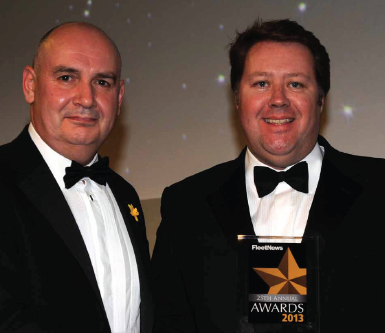Justin Patterson already had a collection of trophies from the Fleet Van Awards and highly commended shields from the Fleet News Awards, recognising his excellent work running the Mitie fleet. But the big one had eluded him.
That was until last year, when he was named the Fleet News Awards fleet manager of the year, describing the moment as “one of the proudest in my career”.
Patterson has headed the Mitie fleet team for the past six years, during which time the strategic outsourcing company has rapidly grown, both organically and on the back of a number of acquisitions. When he joined it operated 3,600 vehicles; today that figure sits at 7,400.
However, where most fleets would be weighed down by the relentless firefighting involved in mergers and the subsequent bringing together of disparate fleet operations, Patterson has a dedicated member of staff who focuses on bringing new acquisitions up to speed with Mitie’s policies.
The right processes make the integration much smoother, he says.
Fleet News: Mitie has acquired a lot of business in recent years, each of which has had a fleet to integrate. How difficult is this process, and what can you learn from it?
Justin Patterson: The key to integration is to understand where the fleet has come from and the benefits of standardising its policies into our own.
It gives us greater economies of scale and also ensures we have one policy for everyone within the business, which minimises risk. We try to take the best elements of any fleet we take on and introduce them into our own policy.
However, a lot of smaller fleets don’t always have the expertise. They are used to doing things in a certain way, but it may not be in an optimal way. By streamlining with our larger fleet there can be large operational savings, especially in the way we maximise our supply chain with our key suppliers, such as rental, fuel cards, accident management and funding.
FN: What are your priorities for 2014?
JP: We are reviewing some of our key partners in terms of vehicle supply and the way we operate in-life services. This is not just about cost, it’s also about innovation and any ways in which they can streamline our processes – added value relationships outweigh simple cost.
We also plan to further automate our driver web portal so drivers can interact directly and self-deliver in a number of areas including booking services and rental vehicles, updating their records and mileage capture. We’re empowering our people on the ground which will provide a more interactive customer experience and increase efficiencies.
FN: What challenges do you foresee for this year?
JP: Our biggest challenge is business and driver behaviour. The low-hanging fruit has gone and we are now challenging thought patterns and developing our self-deliver function which will enable us to dictate which route drivers go down because we control it in the background.
We are also continuing to drive down fuel costs by flipping our model on private mileage. Fuel accounts for a large part of our fleet spend, but our new model aims to drive better behaviour. In flipping the model, our drivers will inform the business of their work miles at the end of each month and pay back the remainder – their private miles.
We are introducing this in April and this change will help our drivers to drive more economically, reduce their overall fuel spend, and so bring down the cost of fuel both for our drivers, and the business as a whole.
FN: How do you see the future of fleet management? Will there always be a need for fleet managers?
JP: Business will always require mobility management; it is a key part of any effective operational company, along with excellent MI (management information).
There are so many facets to fleet and lots of interdependencies. It’s not just about buying vehicles, it’s about managing the assets and controlling the driver. There is always a risk of costs spiralling out of control and it can happen very quickly.
I think that fleet will take on more of a holistic role – managing the journey, the driver and the assets.
For example, depending on the journey, a company car might not always be the best way for an individual to travel; train, rental car or pool car might be more efficient. Fleet’s remit may expand into journey management, but the driver and the asset will always be the core part of the job.
FN: What are the biggest initiatives you have introduced to the Mitie fleet, the ones that have been most successful?
JP: We’ve taken a long-term approach and de-coupled a lot of the elements at the operational end and, where there is added value, joined them back up again.
We have pay-on-use SMR, a standalone commercial vehicle funding deal, daily rental and accident management as a separate area, to name but a few.
The next stage is to look at blended solutions for the company car fleet. Implementing these initiatives is a journey, especially when dealing with a large and complex fleet.
But we’ve seen the benefits: visibility of costs and knowing the impact and costs of our behaviour which, in turn, drives positive behaviour for the business and drivers. It’s important to be able to control cost at a granular level and link it back to behaviour.
FN: What advice would you have to new fleet managers, or those considering a career in fleet?
JP: Businesses can sometimes consider fleet an afterthought, but there are significant savings to be made if it is an area of focus. It’s important to understand the true cost of operating a fleet; get a handle on the data and understand all the elements of cost and supply chain.
It’s also important to understand the blend of driver, asset and journey; in doing so you can drive value and innovation in the business. There’s a huge amount to be gained from looking at those areas before addressing more complex issues.
The company operates vehicles for a maximum of 48 months or 120,000 miles, whichever comes soonest, although specialist vehicles are replaced on a case-by-case basis.
“Our pay-on-use maintenance process enables us to monitor and benchmark our pence per mile along with downtime management,” Patterson says.
“Coupled with mileage feeds, this enables us to accurately predict replacement cycles and see that after 42 months, downtime and associated costs increase disproportionately to the timeline.”
In addition, car terms are based on business usage profiles and model type as SMR budgets rise significantly over the 100,000-mile mark.
Patterson also keeps a close eye on vehicle technology, evaluating whether Mitie might benefit from stepping up the replacement of certain models if more efficient versions are launched.
“We have saved considerable sums through bringing forward replacement of inefficient vehicles as technology moves at a pace beyond our usual cycles,” he adds.
Judges' comments: Justin manages a hugely complex fleet and one that is constantly growing through company acquisitions. He has implemented a range of initiatives to reduce funding and operating costs with particular successes on stock vehicles, guaranteed supply dates, incident rates and fuel costs. Benchmarking is carried out at all levels of business, resulting in a highly costefficient and effective fleet. “
Factfile:
Organisation: Mitie
Head of fleet management: Justin Patterson
Fleet size: 7,400; cars – 3,000, vans – 4,400
Funding method: leasing
Replacement cycle four years/120,000 miles
Funding partner Lex Autolease, Zenith, Barclays, Santander
Brands on fleet: cars - Vauxhall, Audi, BMW; vans – Vauxhall, Ford


















Login to comment
Comments
No comments have been made yet.